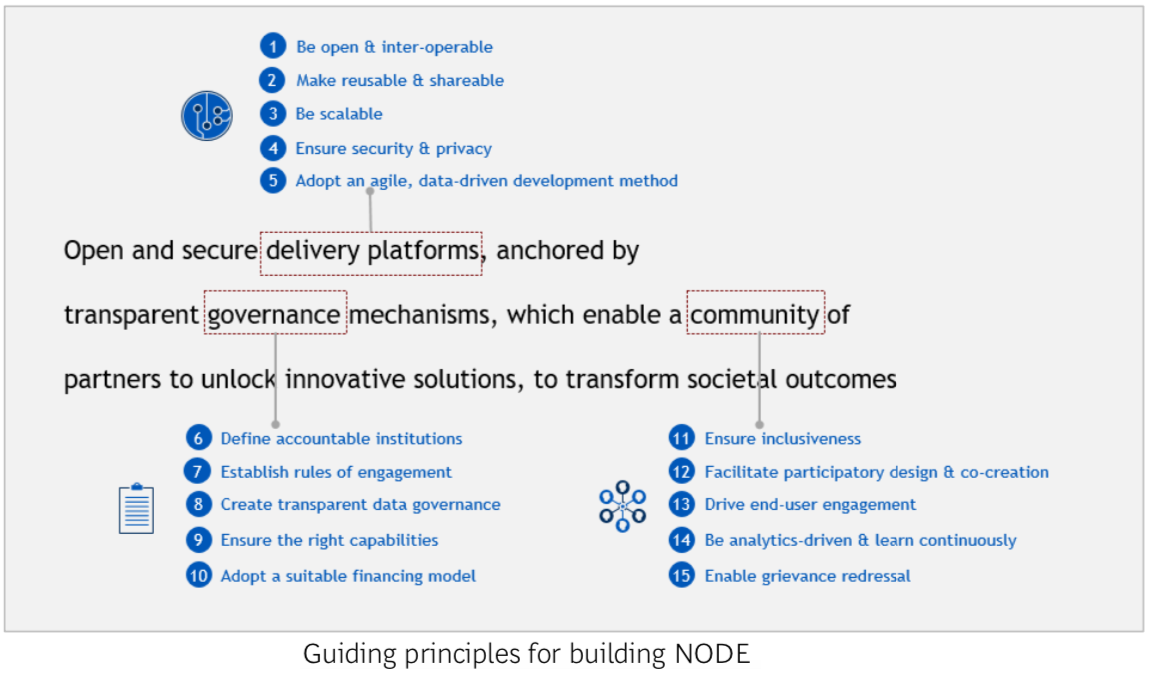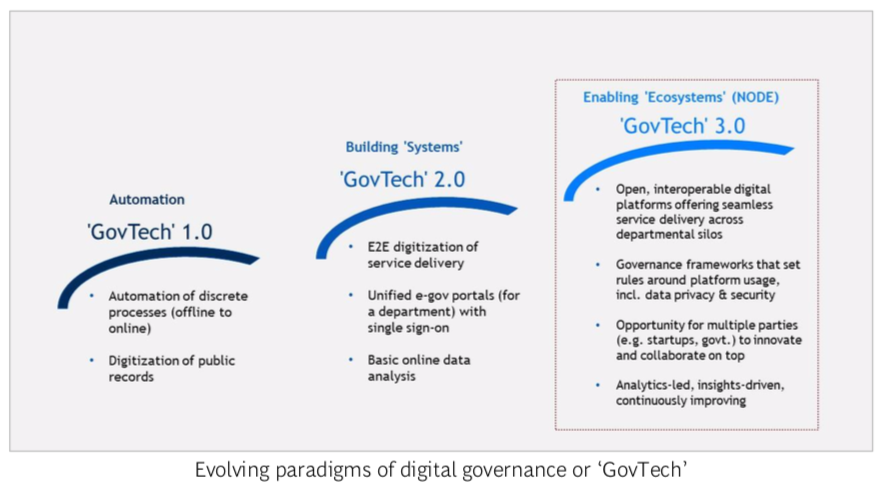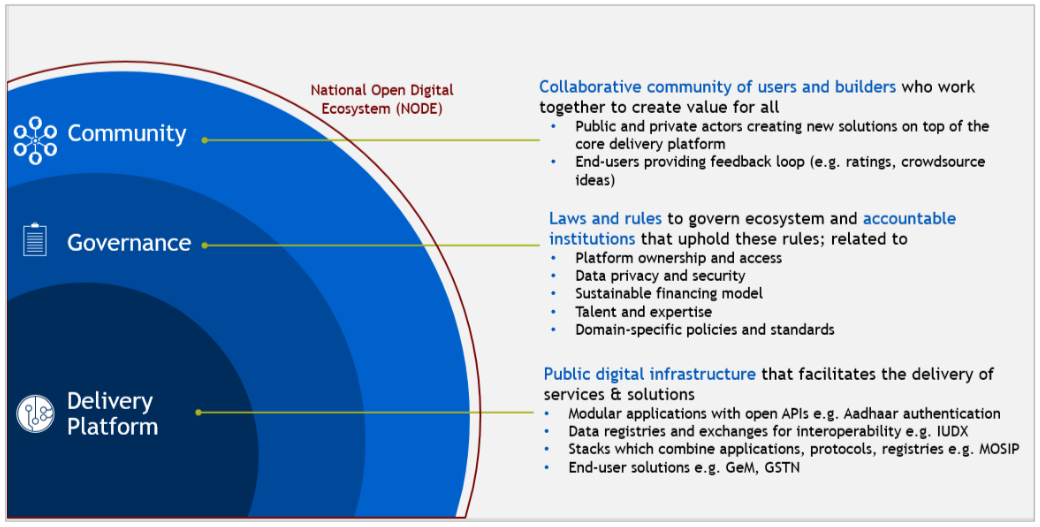Governance
GovTech 3.0
- 15 Jun 2020
- 7 min read
This article is based on “Covid-19 has opened the doors for Gov Tech 3.0” which was published in the Hindustan Times on 11/06/2020. It talks about the challenges and Utility of the National Open Digital Ecosystem.
As India looks to adopt the maxim of “minimum government and maximum governance”, the role of digital ecosystems has become paramount. In this context, recently, the Ministry of Electronics of Information Technology (MeITY) has released a consultation paper on Strategy for National Open Digital Ecosystem (NODE).
NODE or GovTech 3.0 defined as “Open and secure delivery platforms, anchored by transparent governance mechanisms, which enable a technology collaboration among citizens, businesses and governments to transform societal outcomes.
The key objectives Govtech 3.0 include the need to optimise service delivery, integrate data across departments and ministries, create inter-operable and modular platforms and include the private sector by allowing them to build solutions on top of Government architecture.
While the Open Digital Ecosystem (ODE) empowers and enable collaboration in unprecedented ways, there are many underlying challenges emanating from such interconnected digital networks that need to be addressed.
Note: Evolution of GovTech (Use of Technology in Governance)
- Gov Tech1.0 was the era of “computerisation” of manual processes such as putting income tax forms online.
- Gov Tech 2.0 was about building systems which digitised end-to-end processes, for example, the government’s “e-office” file management system.
- GovTech 3.0 is focussed on Open Digital Ecosystems (ODEs), the underlying philosophy suggests that the government should focus on creating the “digital commons”.
- It envisages the government becoming a facilitator by creating digital infrastructure on which innovators can collaboratively build solutions for the public good.
- For Examples, deployment of contact tracing apps (Aarogya Setu) developed through public-private partnerships, to prevent the spread of the virus.
Advantages of GovTech 3.0
- Integration of Government Services: The advantages of building NODE is illustrated citing the example of e-Transport project of the Ministry of Road Transport and Highways (MORTH).
- The ministry helped digitize issuing vehicle registrations and driver’s licenses making it easier for citizens to obtain them, creating dashboards with analytics.
- It now integrates a National Vehicle Register and State Vehicle Registers with data interlinked across databases with access to government institutions like Police, National Crime Records Bureau and private institutions like banks and insurance companies.
- Enhancing Social Security: Several path-breaking ODEs are already in play in India. For example:
- Unified Payments Interface (UPI) in the financial services space has played an instrumental role in increasing financial inclusion.
- The National Digital Infrastructure for Teachers called DIKSHA will play a crucial role in education reforms.
- The National Urban Innovation Stack which is enabling the more efficient provision of municipal services.
- Similarly, a digital ecosystem for agriculture which is being designed by an inter-ministerial committee.
Underlying Challenges
- Privacy Issues: Potential violations of privacy and possible weaponization of data is a primary issue related to such digital initiatives.
- Federal Issues: The apps under Govtech 3.0 may end up gathering information which falls under the domain of State subject.
- For Example, the e-transport project has centralized governance of transport which is a state subject according to the constitution.
- May Increase Inequalities: Success in the digital provision of services is dependent on many underlying factors, including digital literacy, education and access to stable and fast telecommunication services.
- In this setting, undertaking large-scale digitisation of services without bridging these digital divides could result in increasing existing inequalities.
- Security Issues: Another cybersecurity challenge is ensuring end-to-end protection of data throughout the whole ecosystem.
- While channels and databases used by the Government for transmission and storage are usually secure, other players in the ecosystem may not possess the requisite expertise or security to prevent and respond to breaches.
- The alleged breach of Aadhar database is a case in point.
Steps To Be Taken
- Addressing Privacy Issues: Designing privacy-protection and secure databases is critical. It is, therefore, imperative, that regulations governing the GovTech 3.0 take into account provisions of the Personal Data Protection Bill, 2019.
- Ensuring Inclusivity: Digital ecosystems should be guided by factors of availability, accessibility, affordability, value and trust.
- Ensuring Transparency: The invisible rules that are coded into “tech” need to be made transparent through thoughtful design principles, legislation, governance frameworks and public engagement.
- Citizen-Centric Design: There is a need to ensure the design is citizen-centric and ensures inclusive access to services at the last mile will help drive adoption and sustain these ecosystems.
Conclusion
The push to create digital ecosystems is a welcome step as it can prove to be an effective tool in overcoming governance deficit and improving the quality of life for individuals. However, it is essential to adapt such ecosystems to the peculiarities of India.
In this context, design choices should be made not just in terms of the technology and data architecture, but also in terms of governance architecture and community engagement around ODEs, will determine how we collaborate to build a more resilient and empowered India.
|
Drishti Mains Question “In pursuit of the maxim of “minimum government and maximum governance”, the role of digital ecosystems has become paramount”. In light this statement, discuss the role and challenges of the National Open Digital Ecosystem. |
This editorial is based on “Much in a Rename” which was published in the Indian express in The Indian Express on 13/06/2020. Now watch this on our Youtube channel.







